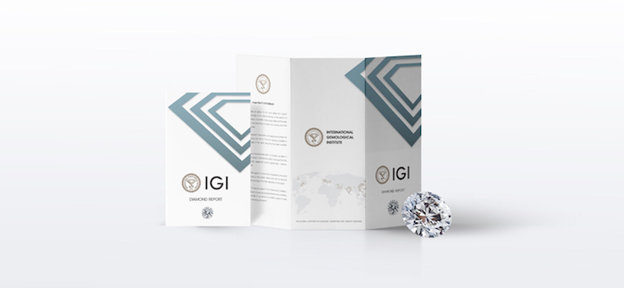This article has mentions of products from one or more companies, and I may receive compensation if you purchase those products following reading my recommendations.
As the name suggests, the International Gemological Institute have a presence across the globe. They’ve been independently grading diamonds for over thirty years, and started out as a real workhorse when it came to diamond certification, a characteristic they’ve stuck to through the years. Today, they are known for working fast and for having lower prices than other diamond grading organizations.
If a diamond is certified by an independent organization, is it worth buying? Not outright. The answer is complex. When it comes to certification, we must always ask the question, ‘is this certification trustworthy?’
This is where our conversation about the IGI comes in. Are they a reliable diamond certification organization? Here’s what I think.

What is Diamond Certification?
DIamond certification is where a diamond (or several) is submitted to an independent grading laboratory, whose specialists use dedicated technical equipment to analyze a diamond for its inherent qualities (or lack thereof).
They will determine the color of a diamond, its weight, its clarity, the quality of its cut, and other features such as its dimensions. This is all added to a diamond grading report, which is essentially like a passport, proving the diamond is as it is described by the vendor selling it.

The IGI is just one of several independent grading entities that operate on the market today. For example, there is also the GIA and the AGS (the two leading organizations), and the EGL (which operates mainly in Europe). You can read more on these organizations here.
The IGI’s Approach
In most of the cases I’ve seen, the IGI have, rather unfortunately, inflated the quality of the diamonds they’ve graded. Let me explain.
Imagine you’re a grading business looking to stay relevant and fast-paced in your work. Diamond retailers come to you because of this, and your low prices. They expect a good grade for their diamonds, or they will take their business elsewhere. You’re forced to give those slightly better gradings, turning a SI1 into a VS2 for example.
This is the most likely explanation for the IGI’s inflation of grades.
Inconsistencies Across the IGI
The IGI has multiple locations where laboratories can be found. For example, they have labs in Botswana, New York, Antwerp, and Mumbai. Now, the issue with this decentralized framework is that some labs are less stringent than others. For example, the Mumbai location has been found to be less strict than the NY location.
You might say, “Oh well, I will just purchase stones certified by the NY lab!”. Unfortunately, this won’t make a difference. While you might actually get a diamond certified in NY, what often happens is that a diamond with an IGI Mumbai certification is re-certified by the NY branch. The NY branch would then ‘honor’ the original grade, thereby giving it a more trusted certificate, but the same faulty grading.
Diamond Grade Inflation: Why You Should Care
For the consumer, inflation is a huge issue. First of all, if you’ve bought a diamond with inflated qualities, this means you’re unable to find peace of mind within this serious purchase—even if you don’t realize it at first.
Secondly, finding a diamond/s with legitimate certification allows you to accurately compare all the ones you’re interested in. There’s no point in comparing two VS2 clarity diamonds for their price if it turns out one of them is actually an SI1.
Thirdly, if you’re buying a diamond with a certification from a company known to be inconsistent, this means you’re more than likely getting a bad deal, and paying too much for a diamond that may not be worth your time or effort.
Inflation helps diamond companies to increase their profit margins on diamonds they may not necessarily make a nice profit on, and, unfortunately, new customers who aren’t familiar with the diamond market are the unwilling targets of these unscrupulous business practices.
What to Look For In Diamond Certification
When it comes to what to look for in diamond certification, there are a number of things you want to keep an eye out for.
First off, try and determine whether the certifier offers a truly unbiased opinion. You can do this by reading similar reviews to this one regarding certification, to see how other retailers and diamond experts view a certain certifier. The best, most legitimate laboratories let absolutely nothing influence the final grading they give on a diamond. For example, if a diamond arrives at the GIA with a certificate already included, or any markings that denote quality, they will completely ignore them, and find out these details for themselves.
The second thing you need to look for is consistency. If a diamond certification organization has multiple laboratories across the world, do they offer consistency in their gradings? A great way to discover this would be to send a diamond for grading at one location, then send it away to a different one with no documentation, just to see if you get the same reports back.
My Final Recommendation
When it comes to buying certified diamonds, you don’t want to leave anything to chance. While certain IGI certifiers (such as New York, which is known for its stringency) are reliable in their grading, others aren’t, and you will most likely never be fully sure that the diamond you’ve bought has been legitimately graded. Essentially, you’re inviting variables into the equation that you cannot control, which is never a good thing to do when dealing in large sums of money.
Overall, I’d always recommend choosing either the GIA or AGS when it comes to diamond certification and also backing up these diamonds with light performance images. If you find a good quality diamond with either of these certificates, you can rest assured knowing that what you’re getting is true to its description. You can find these diamonds at my favorite retailers:
